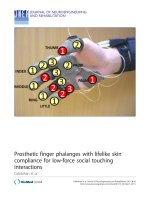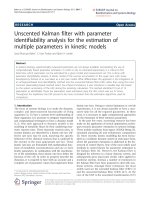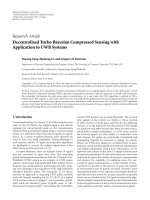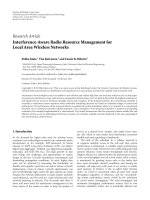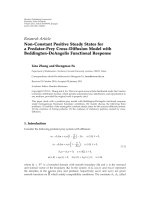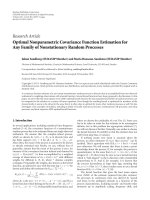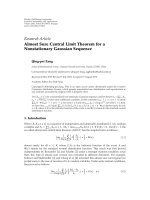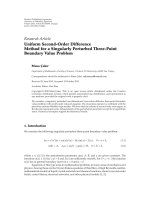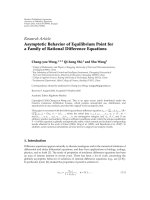Báo cáo hóa học: " Rotated Walsh-Hadamard Spreading with Robust Channel Estimation for a Coded MC-CDMA System" ppt
Bạn đang xem bản rút gọn của tài liệu. Xem và tải ngay bản đầy đủ của tài liệu tại đây (802.96 KB, 10 trang )
EURASIP Journal on Wireless Communications and Networking 2004:1, 74–83
c
2004 Hindawi Publishing Corporation
Rotated Walsh-Hadamard Spreading with Robust
Channel Estimation for a Coded MC-CDMA System
Ronald Raulefs
Research Group for Mobile Radio Transmission, Institute of Communications and Navigation, German Aerospace Center (DLR),
Oberpfaffenhofen, 82234 Wessling, Germany
Email:
Armin Dammann
Research Group for Mobile Radio Transmission, Institute of Communications and Navigation, German Aerospace Center (DLR),
Oberpfaffenhofen, 82234 Wessling, Germany
Email:
Stephan Sand
Research Group for Mobile Radio Transmission, Institute of Communications and Navigation, German Aerospace Center (DLR),
Oberpfaffenhofen, 82234 Wessling, Germany
Email:
Stefan Kaiser
Research Group for Mobile Radio Transmission, Institute of Communications and Navigation, German Aerospace Center (DLR),
Oberpfaffenhofen, 82234 Wessling, Germany
Email:
Gunther Auer
NTT DoCoMo Euro-Labs, 80687 Munich, Germany
Email:
Received 1 November 2003; Revised 2 April 2004
We investigate rotated Walsh-Hadamard spreading matrices for a broadband MC-CDMA system with robust channel estimation
in the synchronous downlink. T he similarities between rotated spreading and signal space diversity are outlined. In a multiuser
MC-CDMA system, possible performance improvements are based on the chosen detector, the channel code, and its Hamming
distance. By applying rotated spreading in comparison to a s tandard Walsh-Hadamard spreading code, a higher throughput can
be achieved. As combining the channel code and the spreading code forms a concatenated code, the overall minimum Hamming
distance of the concatenated code increases. This asymptotically results in an improvement of the bit error rate for high signal-
to-noise ratio. Higher convolutional channel code rates are mostly generated by punctur ing good low-rate channel codes. The
overall Hamming distance decreases significantly for the punctured channel codes. Higher channel code rates are favorable for
MC-CDMA, as MC-CDMA utilizes diversity more efficiently compared to pure OFDMA. The application of rotated spreading in
an MC-CDMA system allows exploiting diversity even further. We demonstrate that the rotated spreading gain is still present for a
robust pilot-aided channel estimator. In a well-designed system, rotated spreading extends the perfor m ance by using a maximum
likelihood detector with robust channel estimation at the receiver by about 1 dB.
Keywords and phrases: code division multiaccess, Walsh-Hadamard spreading sequences, multicarrier, fading channels, concate-
nated channel coding.
1. INTRODUCTION
Multicarrier code-division-multiple access (MC-CDMA) is
a promising candidate for the downlink for the fourth gen-
eration of mobile radio systems. MC-CDMA systems of-
fer the spectral efficiency of orthogonal frequency division
multiplexing (OFDM) combined with CDMA to combat
multiuser interference losses and to offer a flexible mul-
tiuser access scheme. However, in a fully loaded system,
MC-CDMA experiences a significant loss of performance
Rotated Walsh-Hadamard Spreading for a Coded MC-CDMA System 75
due to multiple-access interference. Mobile system operators,
for example, in Germany, have paid tremendous amounts
of money for licenses of the third mobile radio genera-
tion. Therefore, it is essential to identify solutions for fully
loaded systems with high spectral efficiency in the presence
of multiple-access interference. One solution is to perform
complex interference cancellation. These schemes are pro-
posed to enhance the system performance of multiuser sys-
tems [1, 2]. The complexity of multiuser detectors (MUDs)
depends on the maximum number of users to detect. In ad-
dition, a cellular system offers more flexibility with shorter
spreading codes. As the cells of a mobile radio system re-
duce further to increase data rates, especially in hotspots, in-
tercellular interference is more likely. Combining the users
in several small user groups allow by explicit use of fre-
quency bandwidths for a distinct user g roup at the radio cell
boundaries to avoid intercellular interference. The spectral
efficiency in a cell would be reduced, but the system would
beflexibleaslongasthenumberofusersinausergroup
is small. On the other hand, performance gains through ex-
ploitation of diversity by the spreading code increase with the
length of the spreading code. A reasonable spreading length
is based on the overall system parameters.
1.1. Signal space diversity
In this paper, we focus on an MC-CDMA system w ith a
high-rate convolutional channel code and rotated spread-
ing sequences. Both combined allow to exploit diversity in
Rayleigh faded channels more efficiently. Rotated spreading
sequences are derived from signal space or modulation di-
versity approaches. In the following, we briefly recap some
references that focus on signal space diversity.
Signal space or modulation diversity defines a multidi-
mensional signal constellation. The signal constellation is
transmitted over different, ideally independently faded chan-
nels. The latter could be realized, for example, by interleav-
ing. A hig h spectral efficiency without the reduction through
redundancy, for example, through channel coding, could be
accomplished by these diversity schemes. Boull
´
e and Belfiore
[3]presentedanN-dimensional modulation scheme to ex-
ploit time diversity with a lattice decoder. Kerpez presented a
coordinated modulation diversity scheme for several chan-
nels of a digital subscriber line [4]. The performance im-
proves significantly for Rayleigh faded channels by taking
into account a small performance loss for the AWGN chan-
nel. DaSilva and Sousa [5] introduced a fading-resistant
modulation scheme by transmitting the distinct signal points
on different, uncorrelated transmitter antennas. Boutros and
Viterbo [6] presented a rotated approach of the modulation
alphabet that comes close to the AWGN channel bound for a
Rayleigh fading channel. It does not perform worse without
rotated modulation in case of an AWGN channel. Latter is
identified as an important fact that no degradation occurs in
AWGN channels.
In [7], Lamy and Boutros compared Walsh-Hadamard
sequences and rotated lattice structures (random and alge-
braic rotations). They investigated the different schemes for a
16-QAM modulation alphabet. The authors could show that
the possible diversity gains for rotated lattices in a R ayleigh
fading channel are especially sig nificant in comparison to
short lengths of the Walsh-Hadamard sequences. They fur-
ther demonstrated that for a dimension of 512, the diversity
gains for the rotated lattice structures and the pure Walsh-
Hadamard approach differ only marginally. In [8], Brunel
applied a lattice decoder for an MC-CDMA system. The
author construes the possible dimensions generated by the
Walsh-Hadamard sequences as an N-dimensional sphere. He
used this approach to detect and decode the generated chips
by a lattice decoder. In [9], Bury et al. picked up the idea of
rotating the data symbols, and applied that to a CDMA sys-
tem. The authors investigated rotated spreading for BPSK in
an uncoded MC-CDMA system.
All of these schemes have in common omitting any re-
dundancy through channel coding. However, channel cod-
ing is in multicarrier systems a vital source to improve the
performance significantly [10]. In [11], the authors inves-
tigated a turbo-coded OFDM system applying modulation
diversity. Channel coding and a direct-sequence CDMA sys-
tem have been investigated in [12] as a concatenated channel
code. They construe the spreading code as a block code. The
block code combined with the convolutional channel code is
a concatenated system that improves its performance as the
overall Hamming distance increases through the concatena-
tion and with it the slope of the bit error ra te (BER) perfor-
mance versus the signal-to-noise ratio (E
b
/N
0
).
1.2. System aspects
The performance of OFDMA compared to MC-CDMA for
a fully loaded system depends on the channel coding rate
and the ability of the channel code to exploit diversity. For
higher channel codes, for example, a channel coding rate
R > 2/3, OFDMA performs worse than MC-CDMA in a
perfectly interleaved scenario even with a single-user detec-
tor (SUD), like the MMSE detector [2]. A similar scheme
like MC-CDMA is code-division multiple OFDMA (CDM-
OFDMA) [2], where the data symbols of one user are spread
and transmitted combined in a spreading block. The use of
the same data symbols within one spreading block allows
applying this scheme with similar performance also in the
uplink (neglecting any cellular effects). However, in the up-
link, the CDM-OFDM scheme is not affec ted by interfering
data from different users with differently faded channels like
it would be in the uplink for MC-CDMA.
Multicarrier systems based on OFDM have shown that
they perform poorly without any channel coding [ 10]in
time- or frequency-selective Rayleigh fading channels. Com-
bining spectr al efficiency with channel coding calls for high-
rate channel codes, which can be realized by r ate-compatible
punctured convolutional codes (RCPC codes) [13]. RCPCP
codes are derived by puncturing good channel codes (mother
code). The main advantage of RCPC codes is that the de-
coder is the same as for the mother code of the RCPC code.
However, the Hamming distance is decreased significantly
through the higher channel code rate. This makes it harder
76 EURASIP Journal on Wireless Communications and Networking
SourceCoder
π
Mod
S/P
.
.
.
RotSpread
1
.
.
.
L
.
.
.
RotSpread
1
.
.
.
L
.
.
.
1
.
.
.
M
P/S
1
.
.
.
.
.
.
Q
π
Pilots
Pilots
MUX
OFDM
+T
G
Multipath
channel
−T
G
IOFDM
Channel
estimator
Pilot
DEMUX
π
−1
1
.
.
.
Q
CSI
MUD/SUD Demod π
−1
Decoder Sink
Figure 1: The MC-CDMA system with rotated spreading applied at the tr ansmitter.
to collect the possible diversity in a selectively Rayleigh faded
wireless system.
1.3. Rotated spreading
In this paper, we would like to follow the idea of Bury et
al. [9]. The authors showed in their publication that rotated
spreading applied to uncoded systems with BPSK as the cho-
sen modulation alphabet improves the performance signifi-
cantly. In [14], it was shown that the performance of uncoded
systems for 4-QAM is improved by 3 dB at a BER of 10
−3
with
a maximum likelihood sequence estimation (MLSE) detec-
tor and does not improve for a minimum mean square error
(MMSE) detector. In addition, it was shown that significant
improvements are possible in coded systems for high chan-
nel code rates of R = 5/6, if the y apply a maximum likeli-
hood symbol-by-symbol estimator (MLSSE) detector. In this
paper, we add results for R = 3/4 and show that the perfor-
mance depends on the Hamming distance and the constraint
length of the chosen convolutional code. We investigate how
the performance of rotated spreading is affected by robust
channel estimation versus perfect knowledge of the channel
fading coefficient on each subcarr ier. Diversity is increased by
a higher time variability caused by a higher Doppler spread.
This increases the MMSE of the channel estimate, but as we
will see, even for nonperfect channel state information, the
diversity is still exploited.
The paper is organized as follows. In Section 2,we
present the used system model with the multipath channel,
the channel estimator, and the detectors in detail. Section 3
explains the basis of the possible improvements for an MC-
CDMA system. Simulation results in Section 4 show the
improvements for different channels, Hamming distances,
Table 1: Main system parameters.
Parameter Characteristic/value
Bandwidth 101.5MHz
Subcarriers 768
Subcarrier spacing 131.836 kHz
Doppler spread 1% (0.01%)
OFDM symbols/frame 48
Users 4 (full load)
User groups 3
Data symbols/OFDM symbol 64
Spreading factor 4
Data modulation 4-QAM
Code bit interleaver (π) Random interleaver
Subcarrier interleaver (π) 1D random interleaver
Channel coding rate 2/3, 3/4, 3/4, 3/4
(punctured)
Generator polynoms octal (5, 7), (5, 7), (15, 17), (133, 171)
Hamming distance (d
H
)3,3,4,5
Channel estimation 2 × 1-dimensional Wiener filtering
perfect channel estimation, and two one-dimensional (1D)
Wiener filtering. Finally, in Section 5,weconcludeandgivea
brief outlook.
2. SYSTEM MODEL
In this section, the system model is presented. Figure 1 repre-
sents the block diagram of a synchronous MC-CDMA system
in the downlink. Ta ble 1 depicts the main system para meters.
At the transmitter side, there is a binary source for each of
Rotated Walsh-Hadamard Spreading for a Coded MC-CDMA System 77
the K users. The bits of each user are encoded by a convo-
lutional encoder. The code bits are interleaved by a random
code bit interleaver to have more independently distributed
errors at the receiver. T he symbol mapper assigns the bits to
complex-valued data sy mbols according to different alpha-
bets, like PSK or QAM with the chosen cardinality. A serial-
to-parallel (S/P) converter allocates the modulated signals to
M data symbols per user. Each of the M data symbols is ro-
tated and spread with a Walsh-Hadamard sequence of the
length L (K ≤ L) and multiplexed. The combination of rotat-
ing and multiplying each data symbol with a specific Walsh-
Hadamard sequence is defined as rotated spreading. It is like
column rotation of the original Walsh-Hadamard spreading
matrix by specific angles:
W
rot
= W
org
· diag(u),
u
=
u
1
, u
2
, , u
K
T
, u
i
= e
j(2π/B)·(k/K)
, k = 1, , K,
(1)
where W
org
is the Walsh-Hadamard matrix that is used for
spreading the different user signals of a user group and W
rot
is the rotated transform of W
org
; diag(u) defines a diago-
nal matrix with the elements u on the diagonal. k represents
the k
th user 1, , K; B is a constant that is defined by the
modulation cardinality for the PSK alphabet. It is 4 for 4-
QAM, and 8 for the 16-QAM alphabet. The QAM alphabet
is constructed by several differently weighted PSK modulated
rings. The maximum points on any of those rings define the
constant B. This derives the step size of the rotation angle that
is 2π/B. All modulated and spread signals are combined and
form one user group. There are Q user groups and each user
group has M ·L data chips which are interleaved by a random
subcarrier interleaver. The interleaved chips are OFDM mod-
ulated and cyclically extended by the guard interval. The re-
sulting OFDM signal is transmitted over a multipath channel
and corrupted by white Gaussian noise. The different mul-
tipath channel models are described in Section 2.4. The re-
ceiver converts the received signal in the baseband and re-
moves the guard interval. The remaining symbols are OFDM
demodulated and deinterleaved. The pilot demultiplexer re-
moves the pilots and feeds them into the channel estimator.
The 2 × 1-dimensional Wiener filtering channel estimator is
explained in Section 2.1. A demultiplexer identifies the user
group of interest out of the Q different user groups and de-
tects the signal of the desired user with SUD or MUD. The
SUD is performed by the MMSE detector, and the MUD by
the MLSSE for a coded MC-CDMA system. Subsequently,
the equalized signal is despread. Then all data symbols of the
desired user are combined to a serial data stream. The symbol
demapper maps the data symbols into bits and calculates the
log-likelihood ratio (LLR) for each bit based on the selected
alphabet. The code bits are deinterleaved and finally decoded
using soft-decision algorithms.
2.1. Pilot-symbol-aided channel estimation
with a robust Wiener filter
The received symbols of an OFDM frame are given by
R
n,l
= H
n,l
S
n,l
+ Z
n,l
, n = 1, , N
c
, l = 1, , N
s
,(2)
where S
n,l
, Z
n,l
, N
c
,andN
s
are the transmitted symbols, the
AWGN component, the number of subcarriers per OFDM
symbol, and the number of OFDM symbols per frame. The
set of pilot positions in an OFDM frame is P and the number
of pilot sy mbols is N
grid
=P .
The first step in the channel estimation stage is to ob-
tain an initial estimate
ˇ
H
n
,l
of the channel transfer function
(CTF), that is,
ˇ
H
n
,l
=
R
n
,l
S
n
,l
= H
n
,l
+
Z
n
,l
S
n
,l
, ∀{n
, l
}⊂P . (3)
In a second step, the final estimates of the complete
CTF are obtained from the initial estimates
ˇ
H
n
,l
by two-
dimensional (2D) filtering:
ˆ
H
n,l
=
{n
,l
}∈T
n,l
ω
n
,l
,n,l
ˇ
H
n
,l
,(4)
where ω
n
,l
,n,l
is the shift-variant 2D FIR impulse response of
the filter, n = 1, , N
c
,andl = 1, , N
s
[15]. The subset
T
n,l
⊂ P is the set of initial estimates
ˇ
H
n
,l
that are actually
used to estimate
ˆ
H
n,l
. The FIR filter coefficients are based on
the Wiener design criterion. The optimal Wiener filter has
N
grid
filter coefficients, in which case the subset T
n,l
is iden-
tical to the set P .Thefiltercoefficients depend on the dis-
crete time-frequency correlation function (CF) of the CTF
θ
n−n
,l−l
= E{H
n,l
H
∗
n
,l
},forall{n
, l
}∈T
n,l
, and the
noise variance σ
2
.
Due to the wide-sense stationary uncorrelated scatterers
(WSSUS) assumption of the channel, the CF θ
n−n
,l−l
can
be separated into two independent parts:
θ
n−n
,l−l
= θ
n−n
· θ
l−l
,(5)
with θ
n−n
and θ
l−l
representing the discrete frequency and
time CF. This allows to replace the 2D filter by two cascaded
1D filters, one for filtering in frequency direction and the sec-
ond one for filtering in time direction.
The estimates given by the first 1D filter with coefficients
ω
[1]
n
,n
are
ˆ
H
[1]
n,l
=
{n
,l
}∈T
n,l
ω
[1]
n
,n
ˇ
H
n
,l
. (6)
The filter coefficients ω
[1]
n
,n
only depend on the frequency
index n. This operation is performed in all pilot symbols
bearing OFDM symbols. Then the estimate of the second 1D
filter is
ˆ
H
[2]
n,l
=
{n
,l
}∈T
n,l
ω
[2]
l
,l
ˆ
H
[1]
n,l
. (7)
The filter coefficients ω
[2]
l
,l
depend only on the time in-
dex l. The estimates
ˆ
H
[1]
n,l
obtained from the first filtering are
used as pilot symbols for the second filtering on subcarrier n.
Therefore, the second filtering is done on all N
c
subcarriers.
Since in practice, the CF θ
n−n
,l−l
is not perfectly known
at the receiver, the filters of the CE have to be designed such
78 EURASIP Journal on Wireless Communications and Networking
that a great variety of delay power spectral densities (PSDs)
and Doppler PSDs are covered. According to [10], a uniform
delay PSD ranging from 0 to τ
max
and a uniform Doppler
PSD ranging from − f
D,max
to f
D,max
fulfill these require-
ments. Then, the discrete frequency CF results in
θ
n−n
=
sin
πτ
max
(n − n
)F
s
πτ
max
(n − n
)F
s
e
− jπτ
max
(n−n
)F
s
,(8)
and the discrete time CF yields
θ
l−l
=
sin
2πf
D,max
(l − l
)T
s
2πf
D,max
(l − l
)T
s
,(9)
where T
s
denotes the duration of one OFDM symbol includ-
ing the guard interval T
g
.
2.2. MMSE detection
Equalization according to the MMSE criterion minimizes the
mean square value of the error
ε
n
= S
n
− G
n
R
n
(10)
between the transmitted signal and the output of the equal-
izer. The MSE J
n
= E{|ε
n
|
2
} can be minimized by apply-
ing the orthogonality principle [16], stating that the MSE J
n
is minimum if the equalizer coefficient G
n
is selected such
that the error ε
n
is orthogonal to the received signal R
∗
n
, that
is, E{ε
n
R
∗
n
}=0. The equalization coefficients based on the
MMSE criterion result in
G
n
=
H
∗
n
H
n
2
+1/γ
c
, (11)
where the computation of the MMSE equalization coeffi-
cients requires an estimation of the actual SNR per subcarrier
γ
c
.
2.3. Coded MLSSE
The MLSSE minimizes the symbol error probability, which
is equivalent to maximizing the conditional probability
P
{s
(k)
µ
|r} that the data symbol s
(k)
µ
of user k was transmit-
ted and the sig nal r was received, where s
(k)
µ
is one possible
transmitted data symbol of user k, µ = 1, , M
K
,andM
K
is the number of possible transmitted data symbol vectors. If
K ≤ L, the data is a priori known to be 0 for the L − K data
symbols. The estimate of s
(k)
obtained by MLSSE is
ˆ
s
(k)
= arg max
s
(k)
µ
P
s
(k)
r
. (12)
The conditional probability P{s
(k)
|r} is given by
P
s
(k)
r
=
∀s
µ
=s
(k)
P
s
(k)
µ
r
, µ = 1, , M
K
, (13)
where the probability P
{s
(k)
|r} is the union of all mutu-
ally exclusive events P{s
(k)
µ
|r} with the same realization of
s
(k)
[16]. By using Bayes’ rule and assuming that all data
symbols s
(k)
are equally probable and by noting that p(r)
is independent of the transmitted data symbol, the decision
rule based on finding the symbol that maximizes P{s
(k)
|r}
is equivalent to finding the symbol that maximizes p(r |s
(k)
).
Thus, with (12)and(13), the most likely transmitted data
symbol is
ˆ
s
(k)
µ
= arg max
s
(k)
µ
∀s
µ
=s
(k)
µ
exp
−
1
σ
2
∆
2
s
(k)
µ
, r
, (14)
where
∆
2
s
(k)
µ
, r
=
r − HW
rot
s
µ
2
, µ = 1, , M
K
. (15)
The Viterbi decoder uses LLRs of all possible symbols as in-
put, which are calculated by the MLSSE unit. The LLRs for
coded MC-CDMA mobile radio systems applying MLSSE are
given by using all possible transmitter signals:
L
i
= ln
∀s
µ
∈D
+
exp
−
1/σ
2
∆
2
s
µ
, r
∀s
µ
∈D
−
exp
−
1/σ
2
∆
2
s
µ
, r
, (16)
where i is the bit index from 0, ,bitspersymbol· (L − 1).
2.4. Channel models
The simulations are based on a two-path and a twelve-
path time-frequency selective channel model with WSSUS.
Tabl e 2 shows the main channel properties of the two chan-
nel models. The 12-tap channel model (Channel B) imposes
more delay diversity in comparison to the two-tap channel
model (Channel A). The guard interval was chosen accord-
ing to the channel model to ensure that no intersymbol in-
terference and intercarrier interference (ICI) occur. The rate
loss due to the guard interval was not taken into account.
3. ROTATED SPREADING
In this section, the possible improvements offered by rotated
spreading are explained by using the Hamming distance of
the spreading sequence and of the convolutional code.
Each user generates bits, where 0 and 1 are generated with
a probability of 0.5each.Thebitsofeachuserareencodedby
a convolutional encoder with a minimum Hamming distance
d
H
. We apply an MC-CDMA system with Q user groups,
where each group takes up to K users. Each user has M
data symbols which are distributed within one user group
to M subgroups. Each subgroup has the size of the spread-
ing block L. The spreading block combines one data symbol
of each of the K users, where L ≥ K. Each spreading block
forms L chips with the K data sy mbols. All L chips form one
spreading sequence. Traditionally, Walsh-Hadamard spread-
ing codes are used in the downlink of MC-CDMA systems.
They are simple to generate at the transmitter by applying
a fast Walsh-Hadamard [17] transformation for each sub-
group. At the receiver, the Walsh-Hadamard operation is in-
verted and the different user data symbols are extracted. In
Rotated Walsh-Hadamard Spreading for a Coded MC-CDMA System 79
Table 2: Main channel properties.
Path Path delay (µs) Relative average power (dB) Fading characteristics Doppler spectrum form
Channel A
1 0 0 Rayleigh Jakes
260 −3 Rayleigh Jakes
Channel B
1 0 0 Rayleigh Jakes
216 −1 Rayleigh Jakes
332 −2 Rayleigh Jakes
448 −3 Rayleigh Jakes
564 −4 Rayleigh Jakes
680 −5 Rayleigh Jakes
796 −6 Rayleigh Jakes
8 112 −7 Rayleigh Jakes
9 128 −8 Rayleigh Jakes
10 144 −9 Rayleigh Jakes
11 160 −10 Rayleigh Jakes
12 176 −11 Rayleigh Jakes
the following, we will derive the different constellations for
an exemplarily chosen BPSK s ystem.
The Walsh-Hadamard operation generates up to
N
WH
= b
L
(17)
values, where b is two to the power of the number of bits per
symbol (= 2
1
)andL defines the size of the spreading length.
N
WH
consists of only
N
diff ,WH
= L + 1 (18)
different constellations. The major part of all different con-
stellations is 0. The possible chip values are unequally dis-
tributed and occur by using the binomial distribution:
−L =
L
0
, −L+2 =
L
1
, ,0=
L
L
2
, , L =
L
L
. (19)
The scheme can be applied for QPSK by extending the
scheme of BPSK to the second dimension. For QPSK, the
Walsh-Hadamard operation generates
N
WH
=
2
2
L
(20)
values, where only
N
diff ,WH
= (L +1)
2
(21)
are different. The QPSK solution can be easily transferred to
4-QAM by rotating all possible chip values by π/4.
Instead of applying a pure Walsh-Hadamard matrix, we
apply rotated spreading factors for each spreading sequence.
The advantage is that each of the possible N
Rot,WH
constella-
tionsisdifferent. Each of the possible constellations can be
ascribed out of one of the following:
b
L
= N
Rot,WH
= N
WH
. (22)
The different constellations allow that all L different posi-
tions of the spreading sequences differ. Therefore, the min-
imum (which equals the maximum) Hamming distance of
each spreading sequence is L. The higher minimum Ham-
ming distance improves the performance asymptotically. In
comparison, the normal unrotated spreading sequences have
only a minimum Hamming distance of 1. This can be eas-
ily seen by choosing the same value s for each of the L pos-
sible ones. All the L values are multiplied by the Walsh-
Hadamard matrix and summed up. The summed sequence
is L · (s,0, , 0) which means it differsbyjustoneposition
from the null codeword and therefore has a Hamming dis-
tance of 1. In addition, by using −s as a value, the summed
sequence would be L · (−s,0, , 0). The Hamming distance
between all three sequences is 1. The N
Rot,WH
different con-
stellations are advantageous in a fading channel. Whenever
one out of the L constellations is deeply faded, by using the
other constellations, the original signal can be restored more
likely. Figure 2 shows the visible difference for a spread BPSK
system with and without rotation. Only nine different se-
quences exist for nonrotated spreading, and for the rotated,
there are 256 different ones.
In [7, 9], the authors showed that the minimum Eu-
clidean distance of the L data chips is maximized. The to-
tal system is a concatenated system based on an outer and
an inner code. The outer code is the convolutional channel
code.Eachchannelcodeoffers a distinct minimum Ham-
ming distance d
H
. The Hamming distance defines the ability
of the channel code to exploit diversity in a Rayleigh faded
channel. Therefore, the slope of the BER performance for
channel codes with the same Hamming distance is asymp-
totically equal for high SNRs. By applying a second inner
code, the rotated spreading matrix, the second code pro-
vides a second Hamming distance. As it is shown in [17, 18],
the overall minimum Hamming distance is the product of
both minimum Hamming distances. Therefore, the overall
80 EURASIP Journal on Wireless Communications and Networking
−4 −3 −2 −11234
im
re
im
re
Figure 2: Nonrotated and rotated spreading for BPSK and a spreading length of eight.
performance will asymptotically be better for rotated spread-
ing sequences than the unrotated ones.
4. SIMULATION RESULTS
This section shows the simulation results for rotated versus
nonrotated spreading. We investigated uncoded and coded
systems with different code rates (and different minimum
Hamming distances). In addition, we compared an MMSE
and an MLSSE detector and nonperfect channel estimators
with perfect channel estimation. Figure 3 depicts the simu-
lation results for the uncoded performance of non- and ro-
tated spreading sequences with channel B. The results for the
MMSE show no improvements for rotated case. The MMSE
detector is unable to exploit the improved distribution of
the Euclidean distance in the signal space. For the MUD, the
MLSSE improves the performance significantly. Even further,
the single-user bound for a spreading length of eig h t gains
improvement. A longer spreading size allows to distribute the
chips over more subcarriers and therefore to exploit more di-
versity. The gap to the single-user bound is about 1 dB. The
performance of an AWGN channel is plotted as a reference.
Figure 4 shows performance results for a coded system with
robust channel estimation using BPSK as its modulation al-
phabet.IncomparisontoFigure 3, the gain for the rotated
scenario is noticeable for the MMSE detector and for the
MLSSE detector. By applying MLSSE, the gap to the single-
user bound is fixed and does not increase for higher SNRs.
The loss through the robust channel estimation still does al-
low the increased minimum Hamming distance to exploit
the diversity.
Figure 5 compares the SUD and MUD for channel B. The
data is encoded by a convolutional code with rate 3/4and
d
H
= 4. The lower curve shows the single-user bound for a
spreading length of four. The top two curves show the per-
formance of the nonrotated and the rotated spreading ma-
trices using an MMSE detector. The performance is identical
Nonrotated, L = 4, MMSE
Rotated, L = 4, MMSE
Nonrotated, L = 4, MLSSE
Nonrotated, L = 8, MLSSE
Rotated, L = 4, MLSSE
Rotated, L = 8, MLSSE
Single-user bound, L = 4
Single-user bound, L = 8
AWG N
4 6 8 101214
SNR (dB)
1e − 04
1e − 03
1e − 02
1e − 01
1e +00
BER
Figure 3: Performance comparison of rotated and nonrotated
spreading codes with the MMSE and the MLSSE detectors and vari-
able spreading lengths for an uncoded 4-QAM system. Channel B is
applied and the maximum Doppler spread is f
d
= 1%.
for both cases and the rotated spreading matrices cannot im-
prove the performance. On the other hand, by applying the
MLSSE detector at the receiver, the system improves by about
0.7dB. Figure 6 compares the robust pilot-aided with the
perfect channel estimation for rotated spreading sequences
withacoderateof2/3. The gain for the rotated spreading
sequences is nearly 1 dB for a BER of 2 × 10
−4
. The robust
Rotated Walsh-Hadamard Spreading for a Coded MC-CDMA System 81
Nonrotated, MMSE
Nonrotated, MLSSE
Rotated, MMSE
Rotated, MLSSE
Single-user bound
468101214
SNR (dB)
1e − 05
1e − 04
1e − 03
1e − 02
1e − 01
1e +00
BER
Figure 4: Performance comparison of rotated and nonrotated
spreading codes with the MMSE and the MLSSE detectors and ro-
bust or 2 × 1-dimensional channel estimation for BPSK. The con-
volutional code has rate 3/4 and a minimum Hamming distance of
d
H
min
= 4.
Nonrotated, MMSE
Rotated, MMSE
Nonrotated, MLSSE
Rotated, MLSSE
Single-user bound, MLSSE
46 8101214
SNR (dB)
1e − 06
1e − 05
1e − 04
1e − 03
1e − 02
1e − 01
BER
Figure 5: Performance comparison of rotated and nonrotated
spreading codes with the MMSE and the MLSSE detectors and per-
fect channel estimation for 4-QAM. The convolutional code has rate
3/4 and a minimum Hamming distance of d
H
= 4. Note that the
MMSE curves for the rotated and the nonrotated are superposed by
each other.
channel estimation can maintain the performance gains
based on rotated spreading.
In Figure 7, the performance of the rotated and the non-
Nonrotated, robust CE
Rotated, robust CE
Nonrotated, perfect CE
Rotated, perfect CE
468101214
SNR (dB)
1e − 06
1e − 05
1e − 04
1e
− 03
1e − 02
1e − 01
1e +00
BER
Figure 6: Rotated spreading is used for systems applying robust or
2 × 1-dimensional channel estimation (CE) and perfect channel es-
timation. Convolutional code is of rate 2/3andd
H
= 3. The modu-
lation used is 4-QAM and the MLSSE detector is used.
Nonrotated, d
H
= 3
Nonrotated, d
H
= 4
Rotated, d
H
= 3
Rotated, d
H
= 4
Nonrotated, d
H
= 5
Rotated, d
H
= 5
Single-user bound, d
H
= 3
Single-user bound, d
H
= 4
Single-user bound, d
H
= 5
6 8 10 12 14 16 18
SNR (dB)
1e − 06
1e − 05
1e − 04
1e − 03
1e − 02
1e − 01
BER
Figure 7: Rotated spreading with the MLSSE detector and three dif-
ferent channel codes with d
H
= 3, 4,5. The r ate is 3/4. Robust chan-
nel estimation is performed for 4-QAM modulated data symbols.
rotated spreading with a convolutional code with rate 3/4
and different minimum Hamming distances d
H
of the chan-
nel code is shown. The performance gain due to the rotated
82 EURASIP Journal on Wireless Communications and Networking
Nonrotated, f
d
= 0.01%
Rotated, f
d
= 0.01%
Nonrotated, f
d
= 1%
Rotated, f
d
= 1%
4 6 8 101214161820
SNR (dB)
1e − 05
1e − 04
1e − 03
1e − 02
1e − 01
BER
Figure 8: For channel A, the performance remains nearly un-
changed for systems applying rotated spreading. The maximum
Doppler spread is f
d
= 0.01% or f
d
= 1%. The convolutional code
rate is 3/4 and the minimum Hamming distance is d
H
= 3. Robust
channel estimation for 4-QAM modulated data symbols is used.
spreading is above 1 dB in comparison to the nonrotated
spreading. In comparison to Figure 6, the rotated spreading
with a d
H
min
= 4 is slightly better than the nonrotated spread-
ing case with f
d
= 1% at a BER of 10
−4
despite the higher
channel coding rate and the higher throughput.
Figure 8 compares the system performance for a 2-tap
fading channel (channel A). This channel offerslessdiversity
than channel B. The system performance does slightly dif-
fer for the rotated spreading sequences. The additional over-
all increased minimum Hamming distance for the rotated
spreading schemes can not be used to exploit diversity by ap-
plying an MLSSE. This improves slightly for high Doppler of
1%.
5. SUMMARY AND OUTLOOK
For BPSK, an MC-CDMA system with rotated spreading ma-
trices improve the performance with S UD and MUD. By ap-
plying an MLSSE detector, rotated spreading improves the
system performance of a coded and uncoded 4-QAM MC-
CDMA system. The performance gain is no longer accessi-
ble with an SUD like the MMSE. The performance gain in-
creases as the mobile radio channel offers more diversity than
the convolutional channel code could exploit. The rotated
spreading allows to exploit the existing diversity even further.
The rotated spreading performs, despite a higher throughout
with a code rate of 3/4ataBERof10
−4
, better than the un-
rotated case with a code rate of 2/3. These gains can only be
achieved by using an MLSSE detector. The complex detec-
tor at the receiver is the major computational burden. For
a SUD like the MMSE detector, there is no extra gain no-
ticeable. However, due to the rotation, any loss is not possi-
ble, and rotated spreading matrices can be implemented effi-
ciently. The performance improvements depend on the pos-
sible complexity of the receiver. A 2 ×1-dimensional channel
estimator was applied to demonstrate that rotated spread-
ing works without loss in comparison to the perfect channel
estimator. The overall minimum Hamming distance of the
system is increased. The decoding feasibility is not enhanced
and therefore for lower SNRs, no improvement can be noted.
The system investigated here is a downlink MC-CDMA
system. In the uplink, MC-CDMA is not reasonable due to
the high asynchronism between the different users and the
uncorrelated transmission channels for the spread sequences.
It is more likely that a system like CDM-OFDMA [2]willbe
applied. The major difference regarding the presented down-
link scheme is the combination of the data symbols of one
user within one spreading block. Therefore, all chips of one
spreading block are effected by the a correlated multipath
fading channel. As this scheme is applied in the uplink, the
multiuser detector is at the base station and hence the rotated
spreading scheme could be an additional source to exploit di-
versity.
ACKNOWLEDGMENT
The authors would like to thank the anonymous reviewers
for their valuable comments.
REFERENCES
[1] S. Verdu, Multiuser D etection, Cambridge University Press,
Cambridge, UK, 1998.
[2] S. Kaiser, “OFDM code-division multiplexing in fading chan-
nels,” IEEE Trans. Communications, vol. 50, no. 8, pp. 1266–
1273, 2002.
[3] K. Boull
´
e and J. C. Belfiore, “Modulation schemes designed
for the Rayleigh channel,” in Proc. Conference on Information
Sciences and Systems (CISS ’92), pp. 288–293, Princeton, NJ,
USA, March 1992.
[4] K. J. Kerpez, “Constellations for good diversity performance,”
IEEE Trans. Communications, vol. 41, no. 9, pp. 1412–1421,
1993.
[5] V. M. DaSilva and E. S. Sousa, “Fading-resistant modulation
using several transmitter antennas,” IEEE Trans. Communica-
tions, vol. 45, no. 10, pp. 1236–1244, 1997.
[6] J.J.BoutrosandE.Viterbo,“Signalspacediversity:apower-
and bandwidth-efficient diversity technique for the Rayleigh
fading channel,” IEEE Transactions on Information Theory,
vol. 44, no. 4, pp. 1453–1467, 1998.
[7] C. Lamy and J. J. Boutros, “On random rotations diversity
and minimum MSE decoding of lattices,” IEEE Transactions
on Information Theory, vol. 46, no. 4, pp. 1584–1589, 2000.
[8] L. Brunel, “Optimum and sub-optimum multiuser detection
based on sphere decoding for multi-carrier code division mul-
tiple access systems,” in Proc. IEEE International Conference on
Communications (ICC ’02), vol. 3, pp. 1526–1530, New York,
NY, USA, May 2002.
[9] A. Bury, J. Egle, and J. Lindner, “Diversity comparison of
spreading transforms for multicarrier spread spectrum trans-
mission,” IEEE Trans. Communications, vol. 51, no. 5, pp. 774–
781, 2003.
Rotated Walsh-Hadamard Spreading for a Coded MC-CDMA System 83
[10] K. Fazel and S. Kaiser, Multi-Carrier and Spread Spectrum
Systems, John Wiley & Sons, Hoboken, NJ, USA, 2003.
[11] J. J. van de Beek and B. M. Popovic, “Benefits of modulation
diversity in turbo-coded OFDM systems,” in IEEE Vehicular
Technology Conference (VTC ’04), Milano, Italy, May 2004.
[12] T. Frey and M. Bossert, “A first approach to concatenation of
coding and spreading for CDMA-systems,” in Proc. IEEE 4th
International Symposium on Spread Spectrum Techniques and
Applications (ISSSTA ’96), vol. 2, pp. 667–671, Mainz, Ger-
many, September 1996.
[13] J. Hagenauer, “Rate-compatible punctured convolutional
codes (RCPC codes) and their applications,” IEEE Trans.
Communications, vol. 36, no. 4, pp. 389–400, 1988.
[14] R. Raulefs, A. Dammann, S. Kaiser, and G. Auer, “Rotated
spreading sequences for broadband multicarrier-CDMA,” in
IEEE 58th Vehicular Technology Conference (VTC ’03), vol. 2,
pp. 862–865, Orlando, Fla, USA, October 2003.
[15] P. Hoeher, S. Kaiser, and P. Robertson, “Pilot-symbol-aided
channel estimation in time and frequency,” in Proc. IEEE
Global Telecommunications Conference (GLOBECOM ’97),
Commun. Theory Mini-Conf., pp. 90–96, Phoenix, Ariz, USA,
November 1997.
[16] A. Papoulis, Probability, Random Variable and Stochast ic Pro-
cesses, McGraw-Hill, New York, NY, USA, 1st edition, 1991.
[17] J. G. Proakis, Digital Communications, McGraw-Hill, New
York, NY, USA, 3rd edition, 1995.
[18] M. Bossert, Kanalcodierung, B.G.Teubner,Stuttgart,Ger-
many, 1998.
Ronald Raulefs studied electrical engineer-
ing at the University of Kaiserslautern, Ger-
many. From November 1997 till June 1998,
he joined the University of Edinburgh, Scot-
land, as an Erasmus Student. In 1999, he re-
ceived the Dipl Ing. degree from the Uni-
versity of Kaiserslautern, Germany. Since
1999, he has been working as a Researcher
at the Institute of Communications and
Navigation, the German Aerospace Center
(DLR), Oberpfaffenhofen, Germany. His main interests are adap-
tive antennas and detection techniques in multicarrier systems.
Armin Dammann studied electrical engi-
neering from 1991 to 1997 at the Uni-
versity of Ulm, Germany, with main topic
information- and microwave-technology.
In July 1997, he received the Dipl Ing. de-
gree from the University of Ulm. Since 1997,
Armin Dammann is a research staff mem-
ber at the Institute of Communications and
Navigation, the German Aerospace Center
(DLR). He has been involved in several re-
search projects with a focus on navigation signal design for Galileo
(ESA-SDS), MAC layer desig n and simulations for a future aero-
nautical VHF digital link (fVDL), physical layer design and sim-
ulations for a “multimedia car platform” (MCP), and design and
simulation for a 4th generation mobile air interface based on MC-
CDMA.
Stephan Sand received the M.S. degree in
electrical engineering from the University
of Massachusetts Dartmouth, USA, and the
Dipl Ing. degree in communications tech-
nology from the University of Ulm, Ger-
many, in 2001 and 2002, respectively. He
is currently working toward the Ph.D. de-
gree at the Institute of Communications
and Navigation, German Aerospace Center
(DLR), Oberpfaffenhofen, Germany. From
January to April 2004, he was a Visiting Researcher at the NTT Do-
CoMo R&D Center, Yokosuka, Japan, working in the area of MC-
CDMA and channel estimation. His main research interests include
various aspects of mobile communications and signal processing,
such as time-frequency methods for signal processing, space-time
signal processing, MC-CDMA, channel estimation, and multiuser
detection.
Stefan Kaiser received the Dipl Ing. and
Ph.D. degrees in electrical engineering
from the University of Kaiserslautern, Ger-
many, in 1993 and 1998, respectively.
Since 1993, he has b een with the Institute
of Communications and Navigation, Ger-
man Aerospace Center (DLR), Oberpfaf-
fenhofen, Germany, where he is currently
the Head of the Mobile Radio Transmission
Group. In 1998, he was a Visiting Researcher
at the Telecommunications Research Laboratories (TRLabs) in Ed-
monton, Canada, working in the area of wireless communications.
His current research interests include multicarrier communica-
tions, multiple access schemes, and space-time processing for mo-
bile radio applications. Dr. Kaiser is the Coorganizer of the In-
ternational Workshop Series on Multi-Carrier Spread Spectrum
(MC-SS), and he is the Coauthor of the book “Multi-Carrier and
Spread Spectrum Systems” (John Wiley & Sons, 2003) and Coeditor
of the book series “Multi-Carrier Spread Spectr um & Related Top-
ics” (Kluwer Academic Publishers, 2000–2004). He is also the Guest
Editor of several s pecial issues on multicarrier spread spectrum of
the European Transactions on Telecommunications (ETT). He is
the Cochair of the IEEE ICC 2004 Communication Theory Sym-
posium. He is a Senior Member of the IEEE and Member of the
VDE/ITG.
Gunther Auer received the Dipl Ing. de-
gree in electrical engineering from the Uni-
versity of Ulm, Germany, in 1996, and the
Ph.D. degree from the University of Edin-
burgh, UK, in 2000. From 2000 to 2001, he
was a Research and Teaching Assistant with
the University of Karlsruhe (TH), Germany.
Since 2001, he has been a Senior Research
Engineer at NTT DoCoMo Euro-Labs, Mu-
nich, Germany. His research interests in-
clude multicar rier-based communication systems, multiple access
schemes, and statistical signal processing, with an emphasis on
channel estimation and synchronization techniques.
